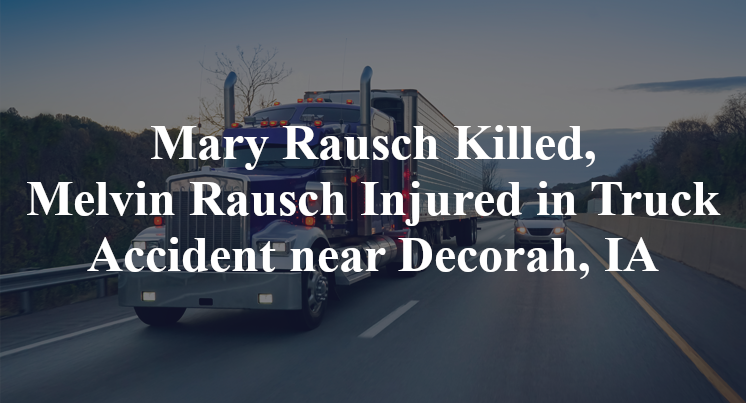Mary Rausch Killed, Melvin Rausch Injured in Truck Accident near Decorah, IA
UPDATE (November 7, 2025): Additional reports have recently been released which have identified the victims of this truck accident; 87-year-old Mary Rausch was the woman who lost her life, while 91-year-old Melvin Rausch was the man who was injured. No further details are currently available. The investigation remains ongoing.
Winneshiek County, IA — October 30, 2025, one person was killed and another was injured due to a truck accident just after 2:00 p.m. along U.S. Highway 52.
According to authorities, a van was traveling southbound on U.S. 52 at the Town Line Road intersection when the accident took place.

Officials indicate that, for as yet unknown reasons, an 18-wheeler that had been traveling on Town Line Road entered the highway at an apparently unsafe time, failing to stop at the stop sign. A collision consequently occurred between the 18-wheeler and the southbound van.
One person reportedly sustained fatal injuries over the course of the accident. A second person suffered injuries of unknown severity, reports state. Additional details pertaining to this incident—including the identities of the victims—are not available at this point in time. The investigation is currently ongoing.
Commentary by Attorney Michael Grossman
When a large truck pulls out onto a highway and crosses into the path of oncoming traffic, the core legal question becomes why that movement was made—and whether it was reasonably safe to do so. Reports here suggest the 18-wheeler entered U.S. 52 without stopping at a posted stop sign, leading directly to a fatal collision. If that’s confirmed by evidence, the fault appears squarely on the truck driver—and possibly the company that put that driver behind the wheel.
Intersections where side roads meet highways are among the most dangerous places for commercial vehicles to make decisions. A truck driver pulling out from a stop sign has the legal obligation to yield to all oncoming traffic until the way is clear. That obligation doesn’t change because a truck is big, slow to accelerate, or in a hurry. The rules are the same: the truck must wait.
That makes it critical to determine whether the driver actually stopped, how far into the highway the truck entered, and whether the driver had a clear view of southbound traffic. Investigators should be looking closely at brake data from the truck's ECM, camera footage if available, and the layout of the intersection—including whether trees, hills, or signage might have limited sightlines.
Even if visibility was poor, it’s the truck driver's responsibility to make sure the road is clear. If that wasn't possible, the correct decision is to wait—not take a chance with oncoming traffic.
Beyond that, investigators will also want to know why the stop was missed—if it was. Was the driver distracted, fatigued, or unfamiliar with the area? Had the company given them poor routing information, or scheduled them in a way that encouraged rushed decisions? These are the kinds of policy-level questions that can turn a simple crash into a broader issue of corporate liability.
Key Takeaways:
- The key legal issue is whether the truck driver failed to stop and yield before entering the highway from a side road.
- If the truck entered at an unsafe time, that may indicate negligence—especially if stop signs or sightlines were ignored.
- ECM data and intersection analysis will help confirm whether the truck slowed or stopped before pulling out.
- Truck drivers have a duty to yield the right-of-way, regardless of pressure to meet deadlines or tight schedules.
- Company oversight, routing, and training policies should be reviewed if the driver was rushed or unfamiliar with the area.

“These are essential reads for anyone dealing with the aftermath of a truck wreck”– Attorney Cory Carlson